Electrical Engineering (EE) Exam > Electrical Engineering (EE) Notes > Network Theory (Electric Circuits) > Kirchhoff's Circuit Laws: KCL & KVL
Kirchhoff's Circuit Laws: KCL & KVL | Network Theory (Electric Circuits) - Electrical Engineering (EE) PDF Download
| Table of contents |

|
| Introduction |

|
| Kirchhoffs First Law – The Current Law, (KCL) |

|
| Kirchhoffs Second Law – The Voltage Law, (KVL) |

|
| Common DC Circuit Theory Terms: |

|
Introduction
-
- Using Kirchhoffs circuit law relating to the junction rule and his closed loop rule, we can calculate and find the currents and voltages around any closed circuit providing we know the values of the electrical components within it.
- We saw in the Resistors tutorial that a single equivalent resistance, (RT) can be found when two or more resistors are connected together in either series, parallel or combinations of both, and that these circuits obey Ohm’s Law.
- However, sometimes in complex circuits such as bridge or T networks, we can not simply use Ohm’s Law alone to find the voltages or currents circulating within the circuit. For these types of calculations we need certain rules which allow us to obtain the circuit equations and for this we can use Kirchhoffs Circuit Law.
- In 1845, a German physicist, Gustav Kirchhoff developed a pair or set of rules or laws which deal with the conservation of current and energy within electrical circuits. These two rules are commonly known as: Kirchhoffs Circuit Laws with one of Kirchhoffs laws dealing with the current flowing around a closed circuit, Kirchhoffs Current Law, (KCL) while the other law deals with the voltage sources present in a closed circuit, Kirchhoffs Voltage Law, (KVL).
Kirchhoffs First Law – The Current Law, (KCL)
- Kirchhoffs Current Law or KCL, states that the “total current or charge entering a junction or node is exactly equal to the charge leaving the node as it has no other place to go except to leave, as no charge is lost within the node“. In other words the algebraic sum of ALL the currents entering and leaving a node must be equal to zero, I(exiting) + I(entering) = 0. This idea by Kirchhoff is commonly known as the Conservation of Charge.
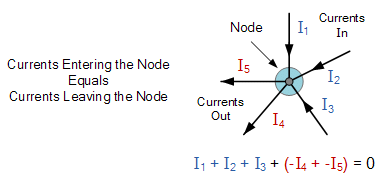
- Here, the three currents entering the node, I1, I2, I3 are all positive in value and the two currents leaving the node, I4 and I5 are negative in value. Then this means we can also rewrite the equation as;
I1 + I2 + I3 – I4 – I5 = 0 - The term Node in an electrical circuit generally refers to a connection or junction of two or more current carrying paths or elements such as cables and components. Also for current to flow either in or out of a node a closed circuit path must exist. We can use Kirchhoff’s current law when analysing parallel circuits.
Kirchhoffs Second Law – The Voltage Law, (KVL)
- Kirchhoffs Voltage Law or KVL, states that “in any closed loop network, the total voltage around the loop is equal to the sum of all the voltage drops within the same loop” which is also equal to zero. In other words the algebraic sum of all voltages within the loop must be equal to zero. This idea by Kirchhoff is known as the Conservation of Energy.
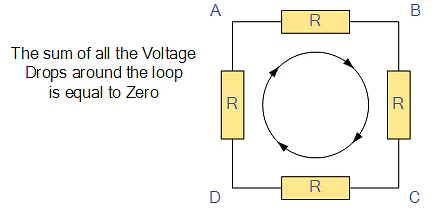
- Starting at any point in the loop continue in the same direction noting the direction of all the voltage drops, either positive or negative, and returning back to the same starting point. It is important to maintain the same direction either clockwise or anti-clockwise or the final voltage sum will not be equal to zero. We can use Kirchhoff’s voltage law when analysing series circuits.
- When analysing either DC circuits or AC circuits using Kirchhoffs Circuit Laws a number of definitions and terminologies are used to describe the parts of the circuit being analysed such as: node, paths, branches, loops and meshes. These terms are used frequently in circuit analysis so it is important to understand them.
Common DC Circuit Theory Terms:
- Circuit – a circuit is a closed loop conducting path in which an electrical current flows.
- Path – a single line of connecting elements or sources.
- Node – a node is a junction, connection or terminal within a circuit were two or more circuit elements are connected or joined together giving a connection point between two or more branches. A node is indicated by a dot.
- Branch – a branch is a single or group of components such as resistors or a source which are connected between two nodes.
- Loop – a loop is a simple closed path in a circuit in which no circuit element or node is encountered more than once.
- Mesh – a mesh is a single closed loop series path that does not contain any other paths. There are no loops inside a mesh.
Note that:
- Components are said to be connected together in Series if the same current value flows through all the components.
- Components are said to be connected together in Parallel if they have the same voltage applied across them.
A Typical DC Circuit
Kirchhoffs Circuit Law Example
Find the current flowing in the 40Ω Resistor, R3

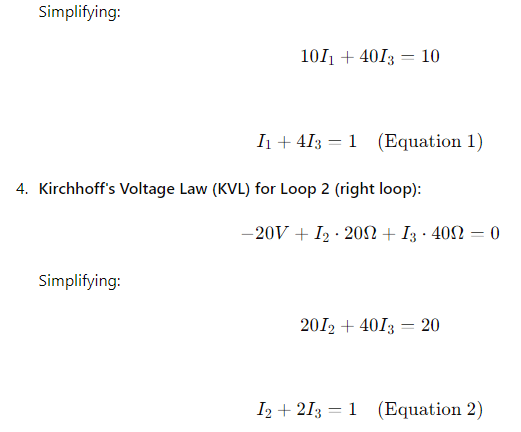
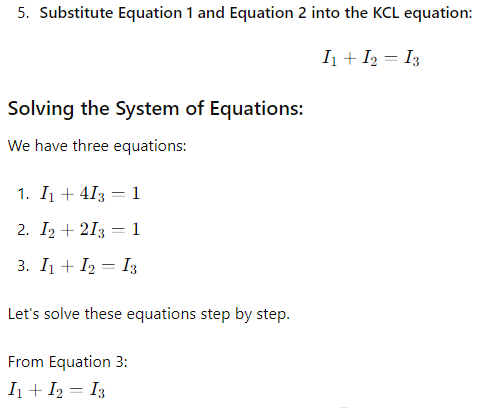
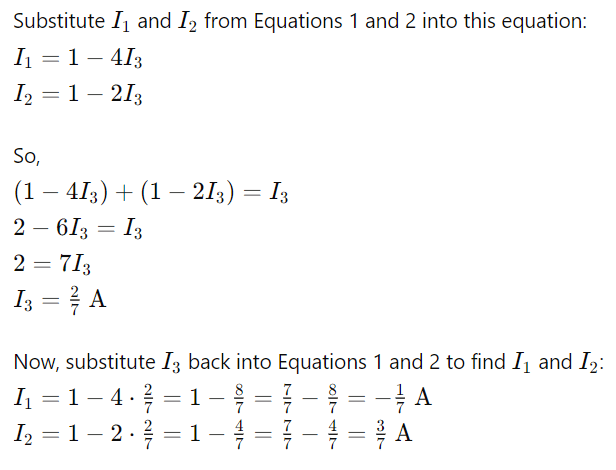
Application of Kirchhoffs Circuit Laws
- These two laws enable the Currents and Voltages in a circuit to be found, ie, the circuit is said to be “Analysed”, and the basic procedure for using Kirchhoff’s Circuit Laws is as follows:
- Assume all voltages and resistances are given. ( If not label them V1, V2,… R1, R2, etc. )
- Assigns a current to each branch or mesh (clockwise or
- anticlockwise)
- Label each branch with a branch current. ( I1, I2, I3 etc. )
- Find Kirchhoff’s first law equations for each node.
- Find Kirchhoff’s second law equations for each of the independent loops of the circuit.
- Use Linear simultaneous equations as required to find the unknown currents.
As well as using Kirchhoffs Circuit Law to calculate the various voltages and currents circulating around a linear circuit, we can also use loop analysis to calculate the currents in each independent loop which helps to reduce the amount of mathematics required by using just Kirchhoff’s laws.
The document Kirchhoff's Circuit Laws: KCL & KVL | Network Theory (Electric Circuits) - Electrical Engineering (EE) is a part of the Electrical Engineering (EE) Course Network Theory (Electric Circuits).
All you need of Electrical Engineering (EE) at this link: Electrical Engineering (EE)
|
73 videos|139 docs|62 tests
|
FAQs on Kirchhoff's Circuit Laws: KCL & KVL - Network Theory (Electric Circuits) - Electrical Engineering (EE)
| 1. What is Kirchhoff's First Law and how is it applied in circuit analysis? |  |
Ans. Kirchhoff's First Law, also known as the Current Law (KCL), states that the total current entering a junction in a circuit is equal to the total current leaving the junction. This law is applied by setting up equations at junctions in a circuit to ensure that current is conserved.
| 2. How is Kirchhoff's Second Law, the Voltage Law (KVL), used in circuit analysis? |  |
Ans. Kirchhoff's Second Law, or the Voltage Law (KVL), states that the sum of the voltage drops in a closed loop in a circuit is equal to the applied voltage. This law is applied by setting up equations around loops in a circuit to analyze the voltage distribution.
| 3. What are some common DC circuit theory terms related to Kirchhoff's laws? |  |
Ans. Some common DC circuit theory terms related to Kirchhoff's laws include nodes, branches, loops, resistors, capacitors, and inductors. Understanding these terms is crucial for applying Kirchhoff's laws in circuit analysis.
| 4. How do Kirchhoff's Circuit Laws help in solving complex circuit problems? |  |
Ans. Kirchhoff's Circuit Laws, KCL and KVL, provide a systematic approach to solving complex circuit problems by applying conservation principles. By setting up equations based on these laws, it becomes possible to analyze and solve circuits with multiple components and sources.
| 5. What are some practical applications of Kirchhoff's laws in real-world circuit design and analysis? |  |
Ans. Kirchhoff's laws are widely used in real-world circuit design and analysis, such as in electronics, electrical engineering, and telecommunications. They are essential tools for analyzing and troubleshooting circuits in various applications, ranging from simple circuits to complex systems.
Related Searches















